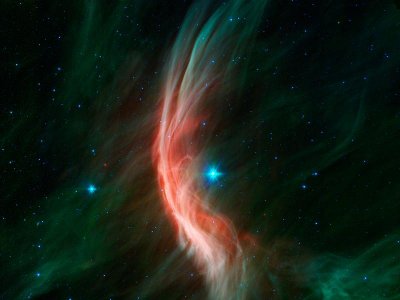
NASA’s Spitzer Space Telescope has allowed scientists to capture the details of the waves created within interstellar dust by the movement of the giant blue star Zeta Ophiuchi. This phenomenon is technically called “bow shock” and indicates the area between a magnetosphere and a surrounding environment.
This case is quite unique because it’s a really intense phenomenon caused by the fact that the star Zeta Ophiuchi is traveling at about 24 kilometers per second (about 15 miles per second), or 86,400 km/h (about 54,000 miles per hour), a very high speed for a star.
The star Zeta Ophiuchi belongs to the spectral class O9V and has a mass about 20 times the Sun, from which it’s about 370 light-years away. Its age is estimated to be of the order of 3-4 million years so it’s very young but because of its huge mass, it will consume its hydrogen very quickly. It’s therefore about around half of its life and in a few million years it will explode in a supernova.
According to astronomers, the star Zeta Ophiuchi in the past had an even more massive companion which at one point exploded in a supernova. The shock wave of the explosion was so violent as to turn Zeta Ophiuchi into a runaway star, which is the technical term indicating the stars that move away from their area of origin at an out-of-the-ordinary speed.
The speed of the star Zeta Ophiuchi is greater than that of sound in the interstellar material that surrounds it. The consequence is that it creates a bow shock in front of it in a structure similar to the waves caused by the bow of a ship in the water it’s traveling. In the image, the star is at the center and the red halo is the bow shock created by it.
The bow shock caused by the star Zeta Ophiuchi is hidden in visible light but appears spectacularly in infrared light. In early 2011, NASA’s WISE (Wide-Field Infrared Survey Explorer) Space Telescope had already captured a similar image but that’s an instrument designed for a more general space survey. Instead, the Spitzer Space Telescope was designed to focus on small areas of the sky and for this reason, it’s been able to capture more details of the area that surrounds Zeta Ophiuchi.
The proportions of this phenomenon are remarkable: the bow shock is about half a light-year from the star Zeta Ophiuchi and has a length of about four light-years. A truly extraordinary show that reminds us once again that the universe is beautiful beyond our imagination!


Permalink
Permalink
Permalink